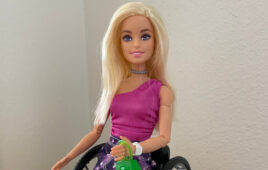
SAD CHILD: DEPOSIT PHOTOS/ZURIJETA
Mobility Management asked Brian
Perkowski, CRTS, ATP, Branch Manager
of National Seating & Mobility’s Wall
Township, N.J., office, how he prioritizes
the many different positioning needs a
Complex Rehab seating and wheeled
mobility client can have.
Q: How do you determine what functions
the seating system needs to achieve? Do
you start with a list of functions that all
wheelchair users need, then add more
specific needs (e.g., head positioning)
according to each specific client?
Brian Perkowski: It’s extremely important
to listen to the client and caregiver for
direction as to what functions their seating
system will require. Understanding their
goals is critical for a successful outcome.
Incorporating their goals, therapist and
physician recommendations, and supplier
knowledge of product ensures the end
user has a comprehensive seating system
that provides support, is aesthetically
appealing, and most importantly, meets
their functional needs.
Q: All positioning goals, from preventing
pressure injuries to supporting transfers,
seem vital. But building a seating system is
often give and take. How do you prioritize?
BP: Prioritizing goals is no easy task, but
again, listening to the client often provides
clues as to what is most important to them.
Professionally educating the client through
the use of demo or trial equipment, historical
experience and the use of technology
via pressure mapping or 3D scanning may
help to guide a client towards making a
decision that the entire complex rehab team
is comfortable with for the seating system.
New wheelchair users and their caregivers,
regardless of age or functional and
cognitive ability, tend to refer back to the
therapist or ATP to assist in deciding on
proper seating systems, as their understanding
of their needs and products
is new and developing. However, more
experienced end users will often come to
the evaluation with an idea, and sometimes
a very specific idea, of what it is they
are looking for in their seating system.
My experience has shown that changing
a cushion for someone that has used a
particular style or brand with good results
for five to 10 years is often not a good idea.
The Complex Rehab seating teams that I
work with always provide education on new
products so that all options are on the table.
Q: Can you think of situations in which
other circumstances impact your prioritization?
For example, if you’re seating
a young child, cognitive, social and
emotional development are crucial.
BP: Considering social and developmental
goals for all clients, especially in pediatrics,
is very important. Designing a piece of
equipment that meets functional needs and
provides the ability to be the most barrier-free primary means of mobility for a young
child can be the difference between full
inclusion at recess or sitting off to the side.
Another point to consider would be
what I call “customer buy-in.” If the
customer doesn’t like the product, for
any reason, they are less likely to use it. It
seems like common sense, but sometimes
we might try to recommend a product that
the client is just not fully on board with yet.
In our professional minds, we justify
the end result, but non-use is a failure
to all. This carries over to the caregiver,
especially with clients who are dependent.
A home environment that is not set up
for an appropriate, but very large, heavy,
and bulky piece of equipment can result
in non-use and actually create a situation
where the client is in bed more often
than in their seating system, resulting in
contractures or other medical issues.

